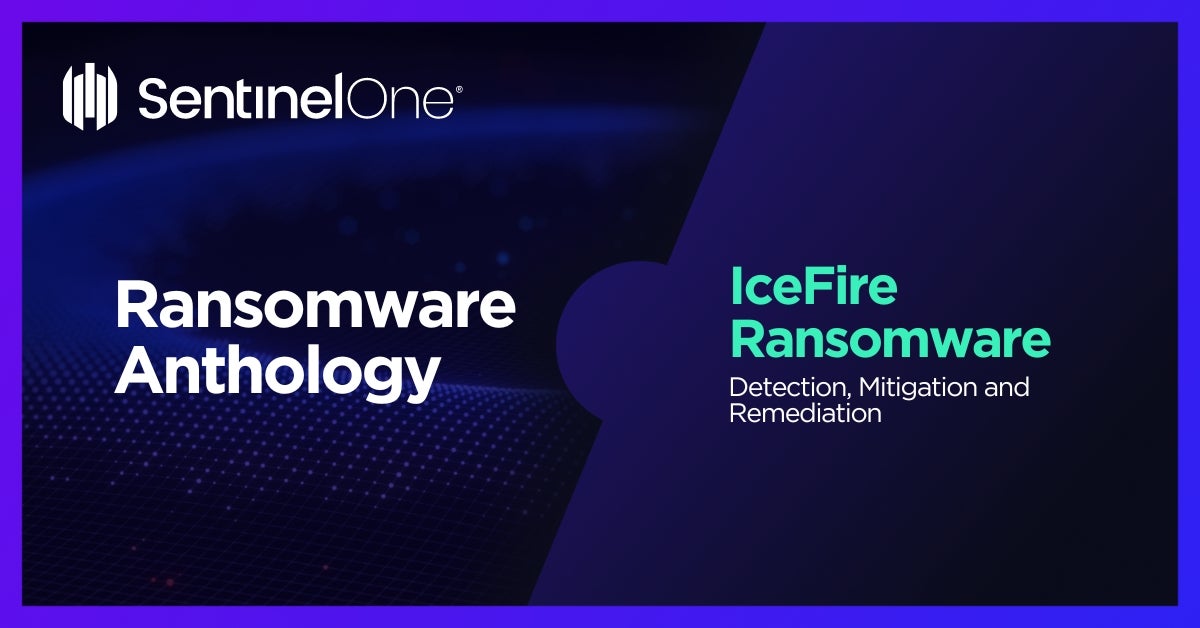IceFire Ransomware: In-Depth Analysis, Detection, Mitigation
Summary of IceFire Ransomware
- IceFire Ransomware was first observed in August 2022.
- IceFire is a multi-pronged extortion threat. The attackers exfiltrate all enticing data prior to encrypting devices. Victims are then extorted into paying the ransom to prevent leakage and decrypt their data.
What Does IceFire Ransomware Target?
- Large enterprises, high-value targets
- Focus on healthcare and education sectors
How Does IceFire Ransomware Spread?
- Phishing and spear phishing emails
- Third-party framework (e.g., Empire, Metasploit, Cobalt Strike)
IceFire Ransomware Technical Details
The malware contains most features considered standard for ransomware (e.g., VSS deletion, multiple persistence mechanisms, log removal). Victims are instructed to visit a TOR-based payment portal to initiate communication with the attacker. Victims are provided unique credentials for their payment portal login, allowing them to chat and interact with their attackers. At this time, there are only Windows versions of IceFire ransomware.
How to Detect IceFire Ransomware
- The SentinelOne Singularity XDR Platform detects and prevents malicious behaviors and artifacts associated with IceFire ransomware.
How to Mitigate IceFire Ransomware
- The SentinelOne Singularity XDR Platform detects and prevents malicious behaviors and artifacts associated with IceFire.
How to Remove IceFire Ransomware
- SentinelOne customers are protected from IceFire ransomware without any need to update or take action. In cases where the policy was set to Detect Only and a device became infected, remove the infection by using SentinelOne’s unique rollback capability. As the accompanying video shows, the rollback will revert any malicious impact on the device and restore encrypted files to their original state.
IceFire Ransomware FAQs
What is IceFire Ransomware?
IceFire is a ransomware that encrypts files and demands money in exchange for decryption. First sighted in March 2022, IceFire first affected Windows platforms and then transitioned to Linux in 2023. IceFire mainly attacks businesses and uses double-extortion tactics. If you are not paying, criminals will release your stolen data. Files receive the.icefire file extension, and ransom files include payment details.
How does IceFire Ransomware spread?
IceFire spreads by exploiting weakness in widely exposed applications, i.e., IBM WebSphere on Linux. Phishing emails with malicious attachments, infected downloads, and brute-force RDP attack are also employed by attackers. Once inside, they move laterally through your network to steal valuable data. Attempts at infection can be detected from network traffic logs.
Which operating systems are targeted by IceFire Ransomware?
IceFire first targeted Windows computers only in 2022. IceFire ventured into Linux computers in 2023 targeting IBM WebSphere vulnerabilities. IceFire is more dangerous because Linux is used on many business critical servers. You must protect all your endpoints from this cross-platform threat if you use both systems.
What types of files does IceFire Ransomware encrypt?
IceFire infects spreadsheets, presentations, documents, databases, images, and source code files. It looks for extensions like.doc,.pdf,.jpg,.sql, and other business-critical files. The ransomware does not infect system files so your computer will be working and you will be able to pay. Your encrypted files will be assigned the.icefire extension.
What encryption algorithms does IceFire Ransomware use?
IceFire uses a combination of RSA and AES encryption. It creates a special AES key that encrypts your files, and encrypts the said key using a public RSA key that can only be decrypted by attackers. No one can break this process without a decryption key. If you look at encrypted files, they’re all sealed forever without the decryption tool of attackers.
Does IceFire Ransomware disable security tools and antivirus software?
Yes, IceFire tries to disable your protection before encryption. It stops security processes, turns off Windows Defender, deletes shadow copies, erases event logs, and turns off recovery options. You can notice your antivirus icon disappearing or security alerts about disabled protection. These actions make detection and recovery harder for you.
What security best practices help prevent IceFire Ransomware infections?
Security practices that stop IceFire include network segmentation to limit movement. Give users only the access they need. Secure RDP with MFA. Block macros in Office documents from the internet. Set up application whitelisting and install EDR solutions. You should also test your incident response plan regularly to stay prepared.
Can endpoint detection and response (EDR) solutions stop IceFire Ransomware?
Yes. SentinelOne Singularity XDR Platform can effectively stop IceFire ransomware attacks.
